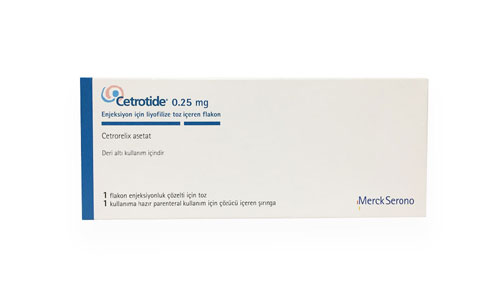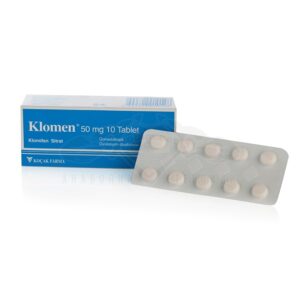Description
Read the entire package insert carefully before using this medicine. Keep this package insert. You may need it again. Consult your doctor or pharmacist if you have additional questions. This medicine has been prescribed only for you. Do not pass it on to anyone else. It may be harmful to them, even if they have the same symptoms as you.
| Frequently Asked Questions | Short Answers |
| How does the medication work? | This is a GnRH antagonist (Gonadotropin-releasing hormone antagonist, active ingredient: Cetrorelix) that blocks the GnRH receptor in the pituitary gland (an organ in our brain). The production of the gonadotropin LH in the pituitary gland is inhibited, causing a rapid decrease in the hormone LH in the blood. This prevents premature ovulation. |
| Does this medication offer the same pregnancy rate as other medications? | All medications used for the same purpose (suppressing your hormonal cycle) in other fertility clinics yield the same pregnancy rate. |
| What is the route of administration for the medication? | The medication should be administered via subcutaneous injection into the abdominal fold. |
| When is the appropriate time to administer the medication? | The medication should be administered once a day, at a self-selected time between 4 p.m. and 8 p.m., for approximately 10 to 14 days. |
| Is it necessary to always administer the medication punctually at the same time? | The medication should always be administered at approximately the same time (+/- 1 hour).
If you remember within 12 hours of the original scheduled time, inject the medication immediately. If you forget for more than 12 hours, do not inject a double dose to make up for the missed dose. |
| Is the medication ready for administration? | No, it’s not ready yet. You must first dissolve it in the dissolving solution provided. Use the syringe that comes with the dissolving solution. |
| Can I learn to self-administer the medication? | Self-administration requires studying the lancing instructions on our website. This may have also been demonstrated by your healthcare provider during the general information session. |
| Can the preparation of the medication cause anxiety? | No, it does not. |
| Can the administration of the medication cause concern? | Yes: The needle is small, thin, and sharp. The first time injecting can be nerve-wracking, so take your time with it and ask for support from your partner or another supportive person. |
| Does the medication have psychological side effects? | You may experience mood swings. |
| Does the medication have common side effects? | The most commonly reported side effects of this medication are local reactions at the injection site. These include erythema, swelling, and itching, which are usually mild and transient. |
| Does the medication cause local side effects? | Yes, you may experience minor bruising and a burning sensation at the injection site. These are considered local side effects of the medication. |
| Can I easily take the medication outside the home (e.g., to work or social activities), and does the medication stand out as targeting fertility? | The medication can be taken outside the home. If you are going abroad, you will need a medical certificate. At border control, you must be able to prove what medication you are transporting. You can request this statement during a visit. Please include your (maiden) name, initials, patient number, and date of birth. Since a clean work surface is needed to prepare the medication, and the abdomen must be bared for abdominal injections, a separate room may be helpful.However, it may be noticeable to those around you that this medication is related to fertility because regular diseases generally do not require injections. |
| How should the medication be stored, and how should the syringes be disposed of? | The syringes should be stored below 25 degrees Celsius in the original packaging to protect them from light. The pharmacy will deliver them to you in a cooler to keep them chilled. The cool box is provided to you free of charge only once. Used needles should be disposed of in a special needle container. Once the container is full, it should be returned to the pharmacy. |
Marketing Authorization Holder:
Serono Europe Limited
56 Marsh Wall
London, E14 9TP
United Kingdom
Manufacturer:
Baxter Oncology GmbH
Daimlerstraße 40
60314 Frankfurt
Germany
1- What is Cetrotide and what is it used for?
OXOTIDE 250 MCG is a powder solution for injection. It is available in packages of one or seven vials. Each package contains:
- 1 pre-filled syringe with solvent (water for injections) to dissolve the powder in the vial.
- 1 hypodermic needle with a yellow mark to inject the water into the vial and to aspirate the dissolved solution.
- 1 hypodermic needle with a gray mark to inject the solution subcutaneously.
- 2 alcohol swabs for cleaning.
OXOTIDE 250 MCG inhibits the effect of a natural hormone called luteinizing hormone-releasing hormone (LHRH). LHRH regulates the release of another hormone, luteinizing hormone (LH), which triggers ovulation during the menstrual cycle. Cetrotide 0.25 mg prevents premature ovulation, which is highly undesirable during hormonal stimulation of the ovaries because only mature eggs are suitable for fertilization.
Therapeutic indications:
Cetrotide 0.25 mg is used to prevent premature ovulation during controlled ovarian stimulation, which is followed by follicle puncture and artificial reproductive techniques.
In clinical studies, Cetrorelix 0.25 mg has been used in combination with human menopausal gonadotropins (hMG). However, limited experience with recombinant FSH suggests similar efficacy. Both hMG and FSH are hormones that promote oocyte maturation.
2- What you need to know before using Cetrotide
Do not use Cetrotide if you:
- are hypersensitive to cetrorelix acetate, exogenous peptide hormones (these are medicines similar to Cetrotide 250 MG), or mannitol
- are pregnant or breastfeeding
- have already reached menopause
- have moderate or severe kidney or liver disease.
Take special care with Cetrotide Special caution should be exercised by women with active hypersensitivity or a history of hypersensitivity. Since Cetrotide is not recommended for women with severe forms of hypersensitivity, you must inform your doctor of any hypersensitivity.
During or after hormonal ovarian stimulation, ovarian hyperstimulation syndrome may occur (the ovaries become over-stimulated). This is related to the stimulation procedure with gonadotropins (hormones that promote egg maturation). For more information about the symptoms and measures to take, please refer to the patient package insert of the gonadotropin-containing drug you were prescribed.
Medication to support the luteal phase (a treatment to support the onset of pregnancy) should be given according to the standard protocol of the fertility clinic. To date, there is limited experience with Cetrotide 0.25 mg when administered during multiple ovarian stimulation treatments. Therefore, you should use Cetrotide 0.25 mg in subsequent cycles only after careful consideration by your doctor.
Pregnancy and Breast-feeding
You should not use Cetrotide 0.25 mg if you are pregnant, suspect you might be pregnant, or if you are breastfeeding.
Using Cetrotide with Other Medicines
Please inform your doctor or pharmacist if you are taking, or have recently taken, any other medicines. This includes medicines that do not require a prescription.
Experimental studies have shown that interactions with drugs metabolized in the liver are unlikely. However, the possibility of interactions with commonly used drugs cannot be completely ruled out.
3- How is Cetrotide used?
How much Cetrotide should you use and how often? Please follow the instructions below for Cetrotide 0.25 mg unless your doctor has prescribed otherwise. This will ensure optimal effectiveness of Cetrotide 0.25 mg. The contents of 1 vial (Cetrotide 0.25MG) should be administered once daily at 24-hour intervals, either in the morning or in the evening.
Morning administration: Begin treatment with Cetrotide 0.25 on day 5 or 6 of ovarian stimulation (approximately 96 to 120 hours after starting ovarian stimulation) with urinary or recombinant gonadotropins and continue throughout treatment with gonadotropins up to and including the day ovulation is induced.
Evening administration: Begin treatment with Cetrotide 0.25 on day 5 of ovarian stimulation (approximately 96 to 108 hours after starting ovarian stimulation) with urinary or recombinant gonadotrophin and continue throughout treatment with gonadotropin up to and including the evening preceding the day ovulation is induced.
The first injection of Cetrotide should be administered under your doctor’s supervision. You may administer subsequent injections yourself, provided your doctor has informed you of symptoms that may indicate an allergy, as well as the consequences of this reaction and the need for immediate treatment. Cetrotide 0.25 mg should be injected subcutaneously into the lower abdomen, preferably near the navel. To avoid local irritation, choose a different site for injection each day.
Cetrotide 0.25 mg powder should only be dissolved in the water provided in the pre-filled syringe. Do not use the Cetrotide 0.25 mg solution if there are particles in it or if the solution is cloudy.
What to do if you have used more of Cetrotide than you should: Overdosing with Cetrotide 0.25 mg may lead to an extended duration of action, but it is unlikely that acute symptoms of poisoning will occur. Therefore, no special measures are necessary in case of an overdose.
What you should do if you forget to take Cetrotide: If you forget to administer a dose of Cetrotide 0.25 mg on any day, contact your doctor immediately and ask for advice. It is best to administer Cetrotide 0.25 mg at 24-hour intervals. If you missed the administration of Cetrotide 0.25 mg at the designated time, this dose can be administered at another time on the same day without any problem.
4- Possible Side Effects:
Like all drugs, Cetrotide can have side effects. Mild and short-term reactions may occur at the injection site such as redness, itching, and swelling. A few cases of severe, generalized hypersensitivity reactions have also been reported.
Generalized side effects such as nausea and headache have been reported in a few cases. Furthermore, itching has been reported in a single case during treatment with cetrorelix. In some cases, stimulation of the ovaries with gonadotropins (hormones that promote oocyte maturation) can lead to the so-called ovarian hyperstimulation syndrome (OHSS). Symptoms such as abdominal pain, tension, nausea, vomiting, diarrhea, and breathing difficulties may indicate an OHSS. If you experience such symptoms, you should inform your doctor immediately.
If you experience a side effect not mentioned in the package insert, or if you have any doubts about the efficacy of this medicine, please inform your doctor or pharmacist.
5- How to store Cetrotid
Keep the medicine out of the reach and sight of children. Store Cetrotide at a temperature not exceeding 25°C. Keep the vial in the original container to protect it from light.
The Cetrotide powder in the vial and the solvent in the pre-filled syringe share the same expiration date. This date is indicated on the labels and the package.
After preparation, the solution should be administered immediately. Do not use Cetrotide if you notice any visible signs of deterioration. If you have any further questions, please consult your doctor or pharmacist.


